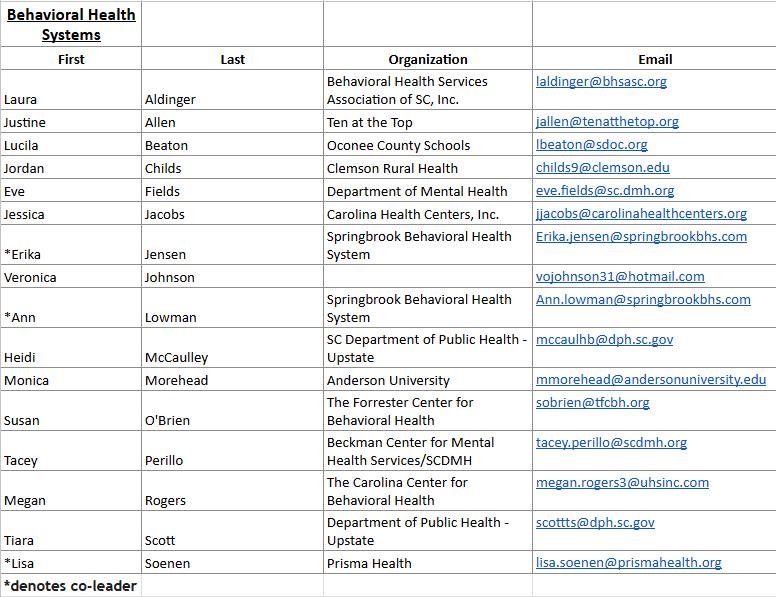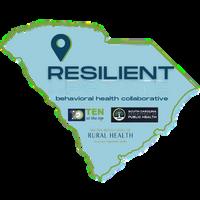




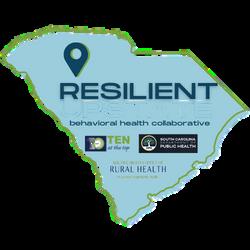
Over the past two years, nonprofit organizations and businesses across the Upstate have collaborated to strengthen the region’s ability to support the mental well-being of its residents.
This effort, known as the Resilient Upstate Behavioral Health Collaborative, has focused on four key areas: Business Linkages, Professional Pipeline, Stigma, and Systems. More information about each is available on the Resilient Upstate Website.
The Business Linkages Task Force has worked to ensure that Upstate employers can easily access tools and resources to support employee mental well-being. The first outcome of this effort is this Workplace Toolkit, designed to help employers build a healthier, more resilient workforce. We hope you will find it useful in your efforts to support the mental well-being of your employees.
Behavioral health, encompassing mental health, suicidal ideation, substance use disorders, and stress-related conditions, is essential to overall well-being.
Healthy employees are key to a strong workplace culture and business success. While many organizations have long prioritized physical health, attention to behavioral health is a more recent but equally important focus.
The Behavioral Health Workplace Toolkit equips employers with knowledge, tools, and resources to foster a mentally healthy workplace.
Benefits of a mentally healthy workplace include:

Increased Productivity: Employees with strong mental well-being are more focused, resilient, and effective.
Enhanced Employee Retention: Supportive environments reduce turnover and improve engagement.
Lower Absenteeism and Presenteeism: Addressing mental health reduces missed workdays and boosts on-the-job performance.
Legal and Ethical Compliance: The toolkit provides basic information on navigating legal obligations such as the Americans with Disabilities Act (ADA), Family and Medical Leave Act (FMLA), and other national and state regulations.
This toolkit underscores the importance of behavioral health and empowers workplaces to prioritize it promoting compliance, inclusivity, and a thriving culture.
Designed to be practical and action-oriented, this toolkit provides a step-by-step approach to implementing effective behavioral health strategies in your workplace.
Engage Leadership: Share the toolkit with HR and leadership to build understanding and commitment. Executive support is essential for meaningful change. Leadership buy-in is crucial for the successful adoption of the practices outlined. Encourage executives and managers to promote behavioral health awareness and lead by example in fostering a supportive culture.
Toolkit Structure:

Follow the Sections in Order: Begin with behavioral health basics (Sections 1 to 3), then explore legal considerations (Section 4), then focus on policy development and supportive environments (Section 6).
Use the Tools and Resources: Assess your current workplace culture, awareness, and systems by using the tools in Section 5. Additionally, explore local and national resources to connect employees with the help they need.
Develop Policies and Training: Utilize the templates and policy examples (Section 4) to develop or enhance behavioral health policies, and refer to training programs (Section 5) to educate employees and managers on recognizing and responding to behavioral health concerns
Evaluate and Adjust: Use the implementation plan (Section 6) to gradually roll out new behavioral health practices and regularly monitor their impact. The toolkit also provides strategies for ongoing evaluation and adjustment to ensure continuous improvement.
By following this guide, you’ll foster a workplace where employees feel supported, valued, and empowered to thrive.
Disclaimer:
This toolkit is intended for informational and educational purposes only and is not a substitute for professional diagnosis, treatment, or medical advice. Individuals experiencing behavioral health concerns should consult a qualified healthcare provider. This material is provided for informational purposes only and does not constitute legal advice. While the guidance is intended to provide general information, it may be prudent to analyze each situation on a case-by-case basis pursuant to applicable federal, state, or local law(s). For legal guidance specific to your situation or workplace, please consult a qualified attorney.

It is well understood that employers need to encourage and support the physical wellbeing of their employees. A healthy employee is generally productive and reliable. However, physical health is just one component of having a fully healthy employee. Unlike physical well-being, the mental well-being of employees has not always been identified as important to monitor and support. In fact, in many professions and cultures, employees that have expressed a need for support around their mental health have historically been slower to receive promotions, increased work responsibilities or other positive opportunities.
Though the health care community has been advocating for “Whole Person Health” for many years, it has only been in the last decade, and most especially since the COVID Pandemic in 2020, that many employers have worked to reduce the stigma around providing mental/behavioral health support for all employees.
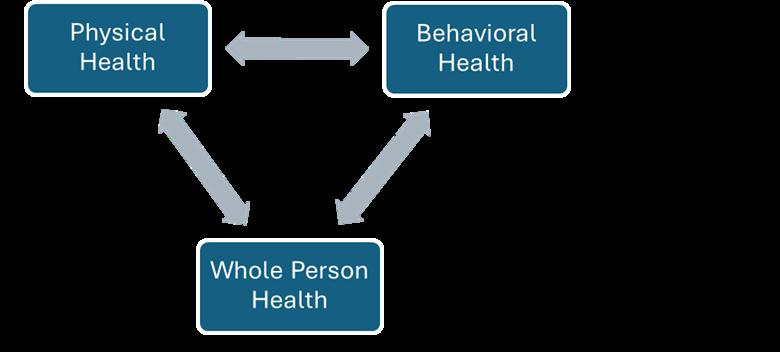

Mental health challenges significantly affect workplace dynamics. According to the American Psychological Association (APA), 71% of workers report experiencing stress that impacts both their mental and physical health, and over 80% consider mental health benefits essential when choosing a job. The World Health Organization (WHO) estimates that depression and anxiety cost the global economy approximately $1 trillion annually in lost productivity. Furthermore, a Deloitte study found that companies supporting their employees' mental health needs experience 30% lower turnover rates.
Domestic violence also profoundly impacts the workplace. Victims often face challenges such as absenteeism, decreased productivity, and safety concerns. The U.S. Department of Labor reports that victims of domestic violence lose nearly 8 million days of paid work each year, resulting in a $1.8 billion loss in productivity for employers. Additionally, 74% of employed domestic violence victims have been harassed at work by their abuser, leading to further disruptions in the workplace.
Substance abuse presents another significant challenge. Employees with substance use disorders (SUDs) are more likely to experience absenteeism, reduced productivity, and increased healthcare costs. For instance, individuals with opioid use disorder miss an average of 15 additional workdays annually, while those with alcohol use disorder miss over 32 days, contributing to more than 232 million missed workdays each year in the U.S. Overall, substance abuse costs U.S. employers approximately $81 billion annually due to lost productivity, absenteeism, and increased healthcare expenses.

Impact of Mental Health, Domestic Violence, and Substance Abuse on the Workplace (cont’d)
Addressing mental health, domestic violence, and substance abuse is crucial for fostering a safe, productive, and supportive work environment.
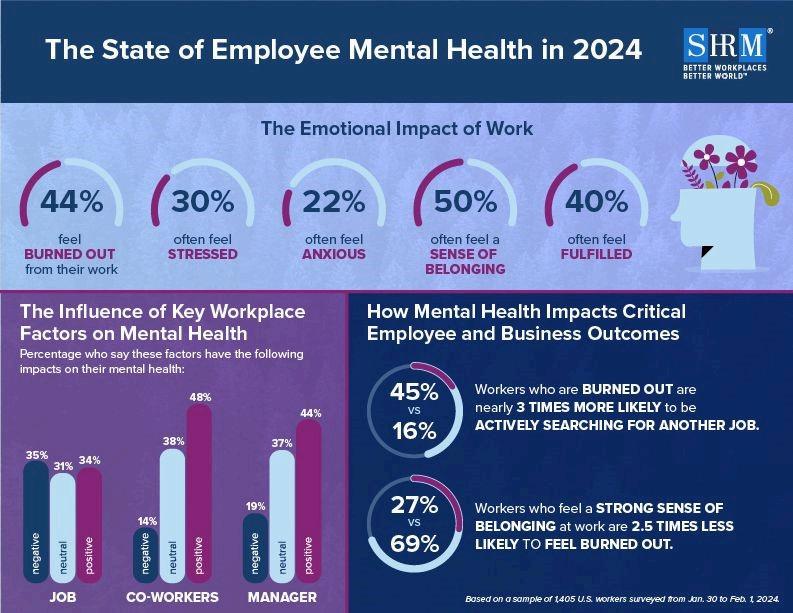
Posted and retrieved May 2, 2025 from this online article: https://www.shrm.org/enterprise-solutions/insights/ease-mental-health-impacts-ofeconomic-anxiety.

Definition: Behavioral health encompasses the promotion of mental well-being, the prevention and treatment of mental and substance use disorders, and the support of individuals with these conditions. It includes a range of factors that influence overall health, such as:
Mental health conditions: e.g., depression, anxiety, bipolar disorder
Substance use disorders: e.g., alcohol and drug misuse
Lifestyle factors: e.g., sleep, nutrition, physical activity
Social and emotional well-being: e.g., stress management, relationship skills, coping mechanisms
Domestic violence: e.g., intimate partner violence affecting physical and psychological safety
Depression:
Definition: Depression is a common and serious mood disorder characterized by persistent feelings of sadness, hopelessness, and a lack of interest or pleasure in activities. It can impair daily functioning and overall quality of life.
Common Symptoms:
Persistent sad, anxious, or "empty" mood
Loss of interest or pleasure in hobbies and activities
Feelings of hopelessness or pessimism
Irritability or frustration
Feelings of guilt, worthlessness, or helplessness
Decreased energy or fatigue
Difficulty concentrating, remembering, or making decisions
Sleep disturbances (insomnia, early-morning awakening, or oversleeping)
Changes in appetite or weight
Unexplained physical symptoms (e.g., aches, pains, headaches, digestive problems)
Workplace Implications:

Reduced Productivity: Employees with depression may experience a 35% reduction in productivity, contributing to significant economic losses due to absenteeism and presenteeism. Modern Health
Increased Absenteeism: Depression can lead to increased sick days and absenteeism, affecting team dynamics and project timelines.
Higher Turnover Rates: Unaddressed mental health issues can result in higher employee turnover, leading to increased recruitment and training costs.
Definition: Anxiety disorders involve excessive fear or worry and related behavioral disturbances. These disorders can interfere with daily activities and relationships. Anxiety:
Common Symptoms:
Excessive worry or fear
Restlessness or feeling on edge
Difficulty concentrating or mind going blank
Irritability
Muscle tension
Sleep disturbances (difficulty falling or staying asleep, restless sleep)
Physical symptoms (e.g., sweating, trembling, dizziness, rapid heartbeat) knoxsheriff.org+19SketchBubble+19SlidePlayer+19
Workplace Implications:
Decreased Performance: Anxiety can impair concentration and decisionmaking, leading to decreased work performance and productivity.
Anxiety:
Workplace Implications (cont’d):

Increased Absenteeism: Employees with anxiety disorders may take more sick days, impacting team efficiency.
Workplace Accidents: High anxiety levels can contribute to workplace accidents due to decreased focus and increased errors.
Definition: Substance use disorders (SUDs) are complex conditions characterized by uncontrolled use of substances despite harmful consequences. They can lead to significant impairments in health, social function, and work productivity.
Common Symptoms:
Strong cravings or urges to use substances
Inability to control or reduce substance use
Neglecting responsibilities at work, school, or home
Continued use despite social or interpersonal problems
Developing tolerance (needing more of the substance for the same effect)
Experiencing withdrawal symptoms when not using the substance
Workplace Implications (cont’d):
Increased Absenteeism: Employees with SUDs have higher rates of absenteeism, missing more workdays annually compared to their peers.
Reduced Productivity: Substance abuse can lead to decreased productivity and work quality, affecting overall organizational performance.
Safety Risks: Impaired judgment and coordination due to substance use can increase the risk of workplace accidents and injuries.

Addressing these behavioral health issues in the workplace is crucial for fostering a safe, productive, and supportive environment. Employers can implement policies, provide resources, and promote a culture of openness to support affected employees and mitigate the associated workplace impacts.
Definition: Domestic violence, also known as intimate partner violence, involves behaviors by a current or former partner or spouse that cause physical, psychological, or sexual harm. This includes acts of physical aggression, sexual coercion, psychological abuse, and controlling behaviors.
Physical injuries (e.g., bruises, fractures)
Psychological effects (e.g., depression, anxiety, post-traumatic stress disorder)
Social isolation
Financial dependence
Disruption of daily activities and routines
Absenteeism: Victims may miss work due to injuries, court appearances, or safety concerns, leading to decreased productivity.
Presenteeism: Even when present, victims may struggle to concentrate or perform effectively due to stress and trauma.
Safety Concerns: Abusers may target victims at their workplace, posing risks to the victim and coworkers.
Economic Impact: Domestic violence costs the U.S. economy billions annually in lost productivity, increased healthcare costs, and legal expenses.

Definition: Suicide risk refers to the likelihood that an individual may attempt or die by suicide. This risk encompasses a range of behaviors, thoughts, and feelings, including suicidal ideation, planning, and previous attempts.
Common Warning Signs:
Expressing feelings of hopelessness or having no reason to live
Talking about wanting to die or to kill oneself
Searching for methods to end one ' s life (e.g., online searches, obtaining weapons)
Talking about feeling trapped or in unbearable pain
Increased use of alcohol or drugs
Withdrawing from friends, family, and activities
Exhibiting extreme mood swings
Giving away prized possessions
Saying goodbye to loved ones as if they won't be seen again
Workplace Implications:
Absenteeism and Presenteeism: Employees experiencing suicidal thoughts may frequently miss work or be present but unable to perform effectively, leading to decreased productivity.
Increased Risk in Certain Occupations: Certain industries, such as construction, have higher suicide rates. For instance, construction workers are four times more likely to die by suicide compared to the national average.
Impact on Coworkers and Organizational Culture: A suicide or suicide attempt within the workplace can have profound effects on coworkers, leading to emotional distress, decreased morale, and a potential increase in turnover rates.
Legal and Financial Consequences: Employers may face legal liabilities and increased insurance costs if it's determined that workplace conditions contributed to an employee's suicide.

By proactively addressing suicide risk, employers can create a safer, more supportive workplace that prioritizes the well-being of all employees.
Implement Mental Health Programs: Establish Employee Assistance Programs (EAPs) that provide confidential counseling and support services.
Foster an Open and Supportive Environment: Encourage open discussions about mental health and ensure employees feel safe seeking help.
Training and Awareness: Provide training for management and staff to recognize warning signs of suicide and understand how to respond appropriately. Access to Resources: Ensure employees have access to mental health resources, including crisis helplines and counseling services.
National Suicide Prevention Lifeline: https://988sc.org/
The 988 Suicide & Crisis Lifeline provides free and confidential emotional support to people in suicidal crisis or emotional distress 24 hours a day, 7 days a week, across the United States and its territories. (CALL OR TEXT 988) 988 Veterans Dial #1
Local Emergency Services: 911
In all communities, calling 911 will connect you with local law enforcement. It should be used in an emergency situation.
United Way Community Help Line: 211
The 211 help line is managed through the United Way of South Carolina as a help line for individuals in need of connecting with a wide variety of community resources and services.

Based on information from the South Carolina Department of Public Health (DPH), more than 16% of all Upstate residents (adults 18+) self-report experiencing 14 or more days of poor mental health each month. This can impact the ability to function at a normal level in the workplace and in typical daily functions. This also impacts their overall quality of life and can also negatively impact physical health.


Collectively, roughly 27% of all residents 18+ in the Upstate have reported being diagnosed with some form of depression. This is higher than the state average, which is around 22%.
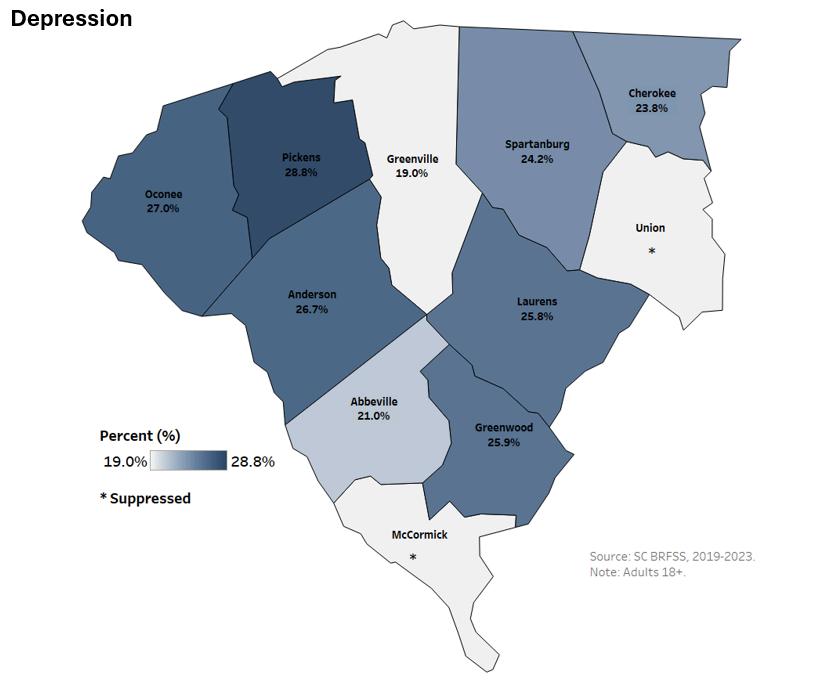

Suicide in the Upstate is ranked as the second leading cause of death for individuals ages 10-14, 15-24, and 25-34. In the Upstate, looking at all population groups in total, there are annually 28.3 deaths by suicide per 100,000 men and 7.2 deaths per female. Both of these are higher than the rate for the entire state of South Carolina.


Drug addiction is part of behavioral health that often is a contributing factor to suicide, depression and other elements of overall mental health. The state of South Carolina sees a total drug overdose mortality rate of 41.0 per 100,000 people. Three Upstate counties have higher rates than the state average.
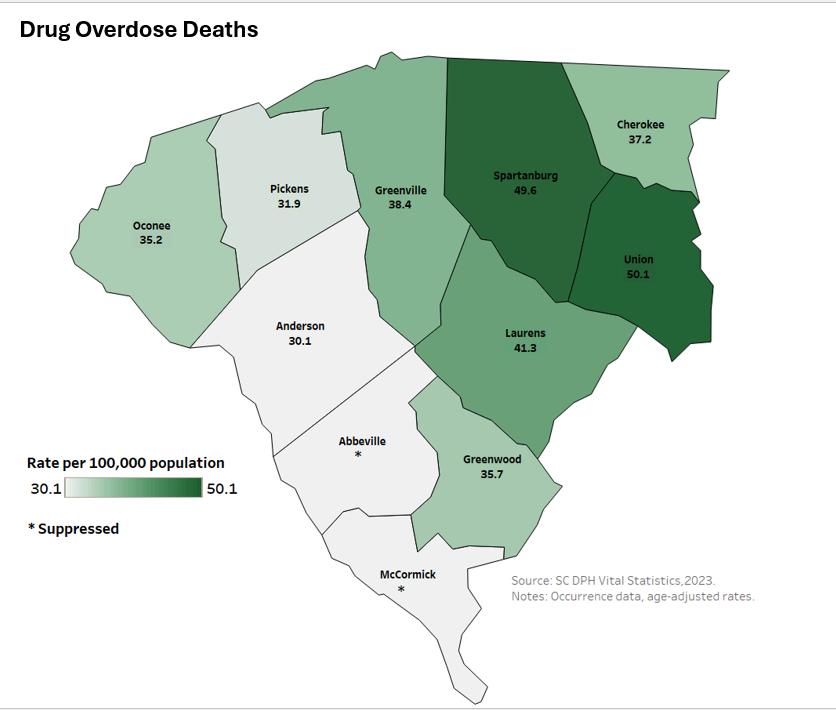

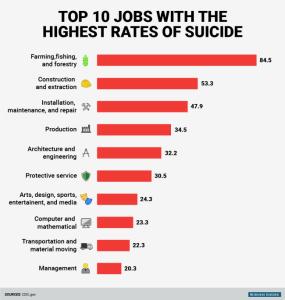

Employers must adhere to various federal, state, and in some instances, local law(s) when addressing behavioral health in the workplace. Below is a general overview of some key legal obligations that may arise in this context:
The ADA prohibits discrimination based on disability, which may include mental health conditions. Among other requirements, Employers must generally:
Provide Reasonable Accommodations: Reasonable accommodations could include adjustments to the workplace such as modified work schedules, a quiet workspace, or time off for treatment, which must be made unless they cause undue hardship. For more information on potential accommodations, visit Job Accommodation Network.
Avoid Discriminatory Practices: Ensure that hiring, promotion, termination, and other employment decisions are free from discrimination against individuals with disabilities, which may include those with behavioral health conditions.
The FMLA allows eligible employees to take up to 12 weeks of unpaid, job-protected leave for serious health conditions, which may include mental health disorders. Among other requirements, Employers must generally:
Permit Leave for Mental Health Treatment: Allow employees to take leave for mental health issues without fear of job loss or retaliation.
Recognize Covered Conditions: Acknowledge that mental health conditions requiring ongoing treatment by a healthcare provider are covered under FMLA.

While OSHA primarily focuses on physical safety, its general duty clause mandates that employers provide a workplace free from recognized hazards, including psychosocial stressors. Among other considerations, Employers should:
Implement Stress-Reduction Policies: Develop strategies to minimize workplace stress and promote mental well-being.
Recognize Psychological Hazards: Understand that an unsafe psychological work environment can be as detrimental as physical hazards.
HIPAA safeguards the confidentiality of health information, including mental health records. Employers sponsoring health plans must:
Ensure Confidentiality: Protect employees' health information and limit access, especially concerning behavioral health diagnoses and treatments.
Safeguard Information Sharing: Implement measures to control how health information is shared within the organization.
In South Carolina, mental health conditions resulting from work-related stress may be compensable under workers’ compensation if:
Extraordinary and Unusual Conditions: The employee proves that the stress or mental injury was caused by extraordinary and unusual conditions of employment. Medical Evidence: There is medical evidence establishing a direct link between the work conditions and the mental health condition.

Ordinary workplace stress or personnel actions (like transfers or demotions) typically do not qualify unless they occur in an extraordinary and unusual manner. For first responders diagnosed with post-traumatic stress disorder (PTSD), the requirement to prove extraordinary and unusual conditions does not apply, recognizing the unique challenges faced in these roles.
By understanding these criteria, employers and employees can better navigate the complexities of workers' compensation claims related to mental health in South Carolina.
Similar to the ADA, this state law prohibits employment discrimination based on disability, which may include behavioral health conditions. Among other requirements, Employers are obligated to:
Provide Reasonable Accommodations: Adjust the work environment or job duties to accommodate employees with disabilities, including mental health conditions, unless it causes undue hardship.
Prevent Discriminatory Practices: Ensure that all employment practices, including hiring, promotion, and termination, are free from discrimination against individuals with disabilities.
Avoid Retaliation: Do not retaliate against employees who file complaints or participate in investigations related to discrimination.
By understanding and complying with these laws, employers can create a supportive and legally compliant environment that promotes the mental well-being of all employees.

Beyond legal compliance, employers should adopt ethical practices to foster a supportive and inclusive environment for employees with behavioral health conditions. The following guidelines encompass both federal and South Carolina-specific considerations:
Maintaining the privacy of employees' mental health conditions and treatment information is paramount. Confidentiality not only ensures legal compliance (e.g., under HIPAA) but also fosters trust within the workplace.
Information Sharing: Details about an employee's behavioral health status should be disclosed only on a need-to-know basis, such as when informing supervisors about necessary accommodations.
Proper management of sensitive mental health information is crucial.
Secure Storage: Mental health records should be securely stored, with access restricted to authorized personnel only.
Digital Records: Electronic records must comply with data protection standards, including encryption and access controls. schac.sc.gov
Training: Supervisors and HR personnel should receive training on handling sensitive information discreetly and in accordance with legal requirements.
Creating an inclusive culture involves destigmatizing mental health conditions and encouraging employees to seek help when needed. Secure Storage: Mental health records should be securely stored, with access restricted to authorized personnel only.

Employee Assistance Programs (EAPs): Implement EAPs or similar services that provide confidential counseling, mental health support, and referrals to specialized services.
Awareness Campaigns: Conduct regular awareness campaigns to educate employees about mental health and available support resources.
Employers should engage in proactive, ethical decision-making regarding behavioral health.
Accessible Resources: Provide mental health resources that are accessible and equitable to all employees.
Fair Accommodations: Ensure fairness in offering reasonable accommodations and leave options.
Psychological Safety: Promote a culture where employees feel comfortable disclosing mental health challenges without fear of discrimination.
By adhering to these ethical practices, employers in South Carolina can cultivate a workplace that respects and supports the behavioral health needs of all employees, aligning with both federal and state laws.
the Workplace
John, a high-performing sales representative, begins exhibiting signs of severe anxiety frequent absences, missed deadlines, and noticeable changes in demeanor. His manager observes these issues and becomes concerned about his declining job performance.

Workplace Scenario: Navigating Behavioral Health Challenges in the Workplace (cont’d)
Employee Hesitation: John may be reluctant to disclose his anxiety due to fear of stigma or potential discrimination.
Employer Responsibility: Employers must respect employees' privacy rights and cannot compel disclosure of medical conditions. However, they can inform employees about available support resources.
Legal Obligation: Under the Americans with Disabilities Act (ADA), employers are required to provide reasonable accommodations for employees with qualifying mental health conditions. The process begins if John requests an accommodation. Thereafter, John and the Employer should engage in what is called the "interactive process " to determine if he has any medical restrictions and whether there are any reasonable accommodations that would be effective for John to perform the essential functions of his job.
Implementation: Accommodations might include flexible scheduling, modified workloads, or providing a quiet workspace.
Information Handling: Any disclosed medical information must be kept confidential and shared only with individuals involved in the accommodation process.
Training: Supervisors and HR personnel should be trained on handling sensitive information in compliance with the Health Insurance Portability and Accountability Act (HIPAA) and other relevant laws.

Workplace Scenario: Navigating Behavioral Health Challenges in the Workplace (cont’d)
Legal and Ethical Considerations:
Performance Management:
Assessment: Employers should distinguish between performance issues stemming from a lack of skill or effort and those resulting from medical conditions.
Approach: A supportive approach involves discussing observed behaviors with the employee and exploring possible accommodations or support mechanisms.
Workplace Safety:
Duty to Act: If an employee's behavior poses a potential risk to themselves or others, employers have a duty to act to ensure workplace safety. Balancing Act: Actions taken should balance safety concerns with respect for the employee's privacy and rights.
Resolution:
John's manager schedules a private meeting to discuss observed changes in performance, expressing concern and offering support. John discloses his struggle with anxiety. The HR department collaborates with John through the "interactive process " to identify reasonable accommodations, such as a flexible work schedule and access to the company ' s Employee Assistance Program (EAP).
Key Takeaways:
Employers should foster an environment where employees feel safe to disclose mental health challenges.
Understanding legal obligations under laws like the ADA and HIPAA is crucial. Proactive communication and accommodations can lead to improved employee well-being and performance.
By addressing behavioral health issues with empathy and in compliance with legal standards, employers can support their employees' well-being and maintain a productive workplace.
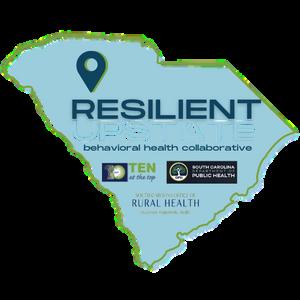
988 Lifeline - If you need emotional support, reach out to the national mental health hotline: 988.Y
988 Veterans Dial #1
Call A Hotline - List of Worldwide Suicide Hotlines | Suicide StopE IN CRISIS AND NEED IMMEDIATE HELP, CALL 911 OR THE NATIONAL SUICIDE PREVENTION HOTLINE
National Resources - Links to national behavioral health organizations and resources, including hotlines and professional association https://www.who.int/news-room/fact-sheets/detail/mental-health-at-work https://www.thehotline.org/support-others/ways-to-support-a-domesticviolence-survivor/
Workplace Toolkit (dol.gov)-National Department of Labor Ecovery Friendly Workplace Toolkit
Red Cross (Search by Zip Code) - Red Cross Resource Directory by findhelpSearch and Connect to Social Care
Mental Health America - Home | Mental Health America
NAMI – National Alliance on Mental Illness - NAMI | National Alliance on Mental Illness
Veteran's Hotline –988 Press 1
Veteran's Administration - Mental Health Home
National Domestic Violence hotline
Call 800-799-7233
Text BEGIN to 88788
Chat: https://chat.thehotline.us/v2/index.html?dkey=783ea42e-3aa0-42f49899-ad886e4995b4&skill=g1b

National Resources - Links to national behavioral health organizations and resources, including hotlines and professional association
Assessment Tools: Tools and surveys to assess behavioral health awareness and the workplace environment.
Mental Health Awareness Month
https://www.samhsa.gov/mental-health-awareness-month
https://www.thenationalcouncil.org/mental-health-awareness-month/
Maslach Burnout Inventory (MBI) - Assessments, Tests | Mind Garden - Mind Garden
Everymind at Work – Workplace Mental Wellbeing Risk Assessment
A free template designed to help organizations assess the physical and psychological environment of their workplace, focusing on factors that influence employee mental health.
https://everymindatwork.com/resource/free-risk-assessment/
CAMH – Workplace Mental Health: Return-to-Work Checklist
Provides a checklist to assist employers in supporting employees returning to work after mental health-related absences, ensuring a smooth and supportive transition.
South Carolina Resource Line - call 211
Abbeville
United Way Lakelands (Greenwood, Abbeville, McCormick)- Resources for Well Being-https://www.lakelandscounts.org/tiles/index/display? id=204383281240830896
Anderson
United Way of Anderson Mental Health First Aid Traininghttps://www.unitedwayofanderson.org/mhfa
Federal, State, & Local Tools, Training & Education Resources

Local/Statewide Resources (cont’d)
South Carolina Resource Line - call 211
Cherokee
United Way of the Piedmont - Cherokee, Union, Spartanburg
Greenville
Greenville Well Being Partnership
United Way of Greenville
Greenwood
United Way Lakelands (Greenwood, Abbeville, McCormick)- Resources for Well Being Laurens
United Way of Laurens County Oconee
United Way of Oconee Pickens
Favor Upstate
United Way of Pickens
Spartanburg
United Way of the Piedmont Resource Guide
Union
United Way of the Piedmont - Cherokee, Union, Spartanburg
Upstate
Walt’s Walz
Palmetto Pathfinders - peer to peer support for veterans
Federal, State, & Local Tools, Training & Education Resources

Mental Health First Aid - Mental Health First Aid teaches you how to identify, understand and respond to signs of mental illnesses and substance use disorders. You learn warning signs for mental health and addiction crises. The training covers strategies to help someone in both crisis and non-crisis situations. You also learn where to turn for help when you need it.
https://www.mentalhealthfirstaid.org/
Mental Health First Aid Training in SC
NAMI SC SC THRIVE
United Way Anderson County
Youth Mental Health First Aid for Parents (free online training)
Domestic Violence and the Workplace Model Policy and Toolkit - Cornell Law School
When Domestic Violence Comes to Work
Recovery Ready Workplace Toolkit
SHRM Workplace Mental Health Ally Certificate
Access to webinars, workshops, and other educational materials to enhance understanding and skills related to workplace behavioral health.
Faith based resources for workshops: https://rebootrecovery.com/trauma/ 12-week, faith-based, peer-led course; specialty groups include Military Reboot and First Responder Reboot
Pet based resources linked here.

Establishing a supportive workplace environment is essential for promoting behavioral health and well-being. This guide outlines strategies for building an inclusive culture, identifying early signs of concern, delivering effective training, and sustaining support systems through ongoing evaluation.
Awareness and Education: Conduct regular training sessions to reduce stigma, increase understanding, and promote acceptance of behavioral health topics.
Open Communication: Foster an environment where employees feel comfortable discussing mental health without fear of judgment or retaliation.
Workplace Accommodations: Provide flexible work arrangements, workload adjustments, or time off to address behavioral health needs.
Clear Policies: Ensure behavioral health support policies—including access to leave, EAPs, accommodations, and crisis support are clearly communicated and easily accessible.
Manager and Supervisor Training: Train leaders to recognize behavioral health warning signs (e.g., absenteeism, mood changes, decreased performance) and address them with compassion and discretion.
Peer Education and Allyship: Encourage a peer support model where trained ambassadors and allies can offer informal support and help navigate resources. Equip them with Mental Health First Aid training and knowledge of internal and external support systems.
Use of Screening Tools: Offer anonymous self-assessments and wellness checkins to help employees identify issues early and seek appropriate support.

Creating a Supportive Environment for Behavioral Health in the Workplace
Integrated Wellness Initiatives: Provide access to mindfulness training, stress management workshops, wellness days, and other proactive supports.
Employee Assistance Programs (EAPs): Promote the availability of confidential counseling and referral services. Ensure employees understand how to access them.
Mental Health Days and Flexibility: Offer designated time off or flexible scheduling to support mental wellness and recovery.
Approach Conversations Carefully: Engage in private, compassionate discussions using non-judgmental language. Focus on observable behavior rather than assumptions.
Encourage Professional Help: Refer employees to EAPs or community mental health services. Support referrals to healthcare providers when distress persists. Offer Reasonable Accommodations: Adjust job responsibilities or schedules as needed in collaboration with HR and based on individual circumstances.
Maintain Confidential Support: Continue to check in regularly, offer encouragement, and monitor well-being without applying pressure.
Emergency Response: Activate crisis procedures in cases of severe distress, including suicidal ideation or erratic behavior. Know when to contact 988, 911, or other crisis services.
Preparedness and Communication: Ensure all employees are aware of the workplace’s emergency response protocol for behavioral health crises.

Creating a Supportive Environment for Behavioral Health in the Workplace
Integrated Wellness Initiatives: Provide access to mindfulness training, stress management workshops, wellness days, and other proactive supports.
Employee Assistance Programs (EAPs): Promote the availability of confidential counseling and referral services. Ensure employees understand how to access them.
Mental Health Days and Flexibility: Offer designated time off or flexible scheduling to support mental wellness and recovery.
Approach Conversations Carefully: Engage in private, compassionate discussions using non-judgmental language. Focus on observable behavior rather than assumptions.
Encourage Professional Help: Refer employees to EAPs or community mental health services. Support referrals to healthcare providers when distress persists. Offer Reasonable Accommodations: Adjust job responsibilities or schedules as needed in collaboration with HR and based on individual circumstances.
Maintain Confidential Support: Continue to check in regularly, offer encouragement, and monitor well-being without applying pressure.
Emergency Response: Activate crisis procedures in cases of severe distress, including suicidal ideation or erratic behavior. Know when to contact 988, 911, or other crisis services.
Preparedness and Communication: Ensure all employees are aware of the workplace’s emergency response protocol for behavioral health crises.
a Supportive

Creating a Supportive Environment for Behavioral Health in the Workplace
Training and Program Integration
Recommended Training Topics:
Mental Health First Aid
Adverse Childhood Experiences (ACEs)
Connection Training (inclusive of cultural and generational differences)
Managing Difficult Conversations
Situational Leadership
Ambassador and Ally Programs:
Ambassadors: Reduce stigma and promote mental wellness through open dialogue, events, and communications.
Allies: Provide trained peer support, resource referrals, and guidance for team members in need.
Peer Support Specialists: Offer deeper engagement, ideally with additional training in Motivational Interviewing and supported by behavioral health professionals.
Program Start-Up Resources:
Mission and justification templates
Role definitions
Sample events and communications (e.g., posters, QR codes)
Tracking templates for participation, EAP utilization, and engagement
Maintain Visibility: Promote mental wellness regularly through campaigns, newsletters, and events.

Creating a Supportive Environment for Behavioral Health in the Workplace
Accountability and Continuous Improvement (cont’d)
Track Impact:
Collect feedback via employee surveys
Monitor event participation and resource usage (e.g., EAP access)
Analyze communication engagement metrics (e.g., intranet page views)
Evaluate and Adapt: Review program outcomes regularly and refine strategies to ensure lasting culture change and relevance.
Promoting an Inclusive Workplace Culture
Awareness and Education: Conduct regular educational sessions to reduce stigma around behavioral health topics
Encouraging Open Communication: Create a safe space for employees to discuss mental health concerns with peers, managers and HR representatives. Workplace Accommodations: Offer flexible work arrangements, workload adjustments, and time to address behavioral health.

“Glow Lyric Theatre is so honored to be a Stigma-Free Zone with Walt’s Waltz. If we are to create the best opera and musical theatre possible, then it is vital that our theatre be a space that acknowledges the importance of mental health. With the goal of the performing arts being to create empathy and understanding of the human condition, we are so proud to partner with a mental health organization like Walt’s Waltz that continues to save lives with its work. What could be more rewarding than that?”
-Jenna Tamisiea Elser, Artistic Director, Glow Lyric Theatre.
"Greenville Center for Creative Arts was honored to become the first Stigma-Free Zone in Upstate South Carolina and support Walt's Waltz in shedding light on the important menta/l health issues that affect our community. As an organization that promotes creativity and connections, GCCA's mission is enhanced by this partnership, which helps us foster a safe and welcoming space for people to express their struggles and feel supported."
Kim Fabian, Former Executive Director, GCCA

To support your efforts in developing workplace behavioral health policies and conducting assessments, I've compiled a selection of checklists, templates, and recommended readings. These resources are designed to assist employers, HR professionals, and organizational leaders in fostering a mentally healthy workplace.
V-Comply’s Free Downloadable Mental Health Policy Template: Offers a structured approach to creating a supportive workplace, emphasizing clear objectives and employee well-being. (Free Downloadable Mental Health Policy Template for Employees)
Workplace Mental Health Checklists
EARN’s Mentally Healthy Workplaces Checklist: Focuses on the "4 A's": Awareness, Accommodations, Assistance, and Access, providing strategies to enhance mental wellness at work. ([PDF] Checklist for Mentally Healthy Workplaces - AWS)
OSHA’s Checklist for Senior Managers: Provides guidance on modifying operations and policies to alleviate workplace stressors. ([PDF] Supporting Mental Health in the Workplace: Checklist for Senior ...)
OSHA’s Checklist for Supervisors: Offers recommendations for supervisors to support mental health and reduce stigma. ([PDF] Supporting Mental Health in the Workplace: Checklist for Supervisors)
St. John Ambulance’s Workplace Mental Health and Wellbeing Checklist: Helps track organizational progress in supporting employee mental health. (Workplace Mental Health and Wellbeing Checklist)

Checklists & Templates for Workplace Behavioral Health (cont’d)
Employee Mental Health and Wellness Checklist Template
ProBizTemplat’s Employee Mental Health and Wellness Checklist: A practical tool to monitor and promote mental health initiatives within the organization.
Recommended Books on Behavioral Health
Here are some insightful books that delve into various aspects of mental health in the workplace:
Mental Health and Wellbeing in the Workplace: A Practical Guide for Employers and Employees by Gill Hasson and Donna Butler
$12.25
Why Workplace Wellbeing Matters: The Science Behind Employee Happiness and Organizational Performance by Jan-Emmanuel De Neve and George Ward
$28.80
How to Stop Trying: An Overachiever’s Guide to Self-Acceptance, Letting Go, and Other Impossible Things by Kate Williams
$26.96
Managing Up: How to Get What You Need from the People in Charge by Melody Wilding
$25.82
Workplace Mental Health Strategy Workbook: A Guide to Getting Started
$21.99

The Resilient Upstate Behavioral Health Collaborative is an effort to leverage the individual and collective expertise, experience, opportunities, and challenges of all entities engaged in supporting behavioral health in the Upstate SC region. The three lead partners for the effort are the South Carolina Office of Rural Health (SC ORH), the South Carolina Department of Public Health (SC DPH), and Ten at the Top (TATT). In 2024, the collaborative developed working groups around four primary areas of focus. Each workgroup met separately to address barriers and resources for behavioral health subtopics identified within each group. They also developed goals and outcomes that will effectively impact the individual and collective capacity of the region around those subtopics.
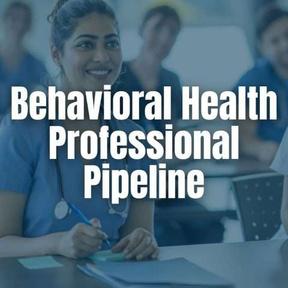
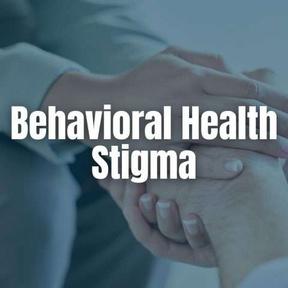

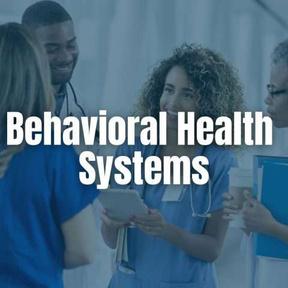
Contact Information & Team Members

Business Linkages Work Group Contact Info
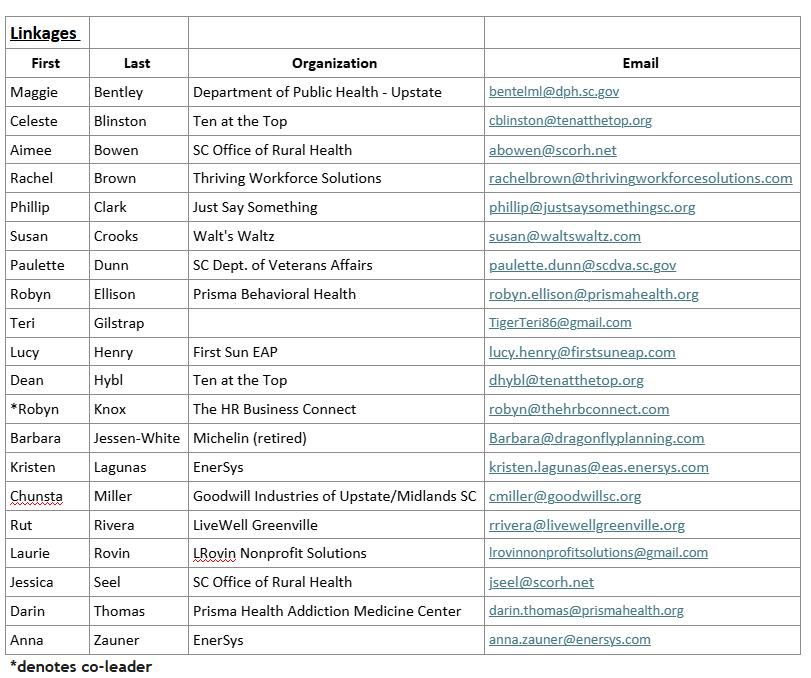

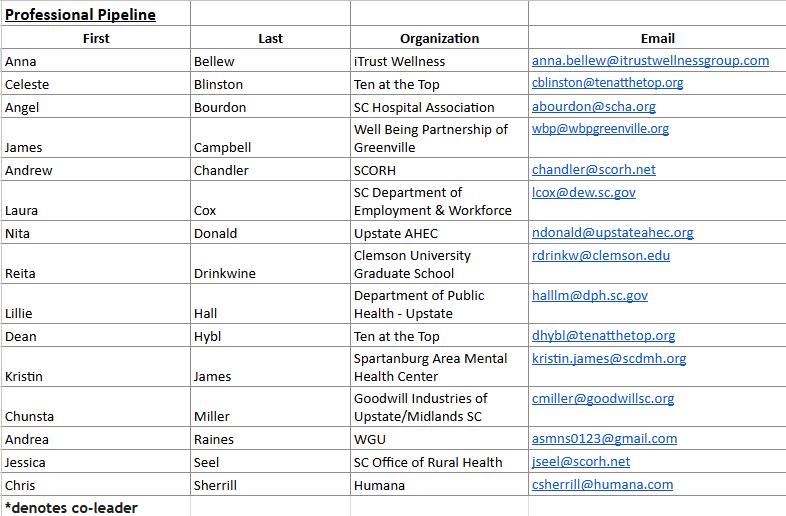

Stigma Work Group Contact Info
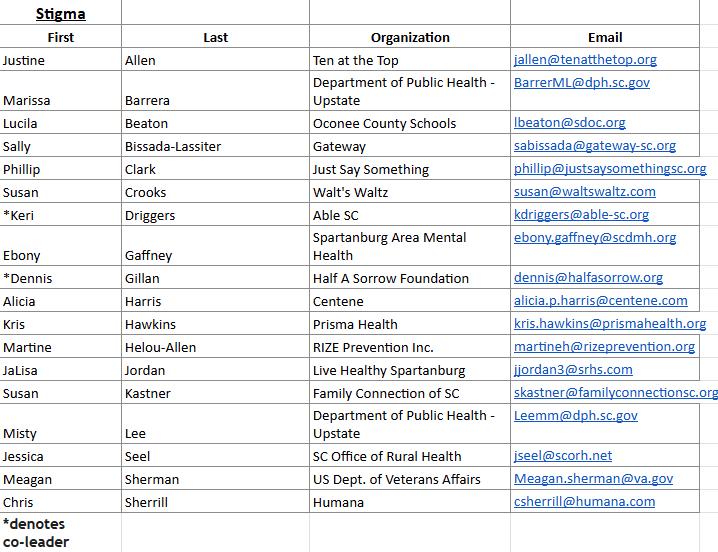
Contact Information & Team Members

Health Systems Work Group Contact Info
